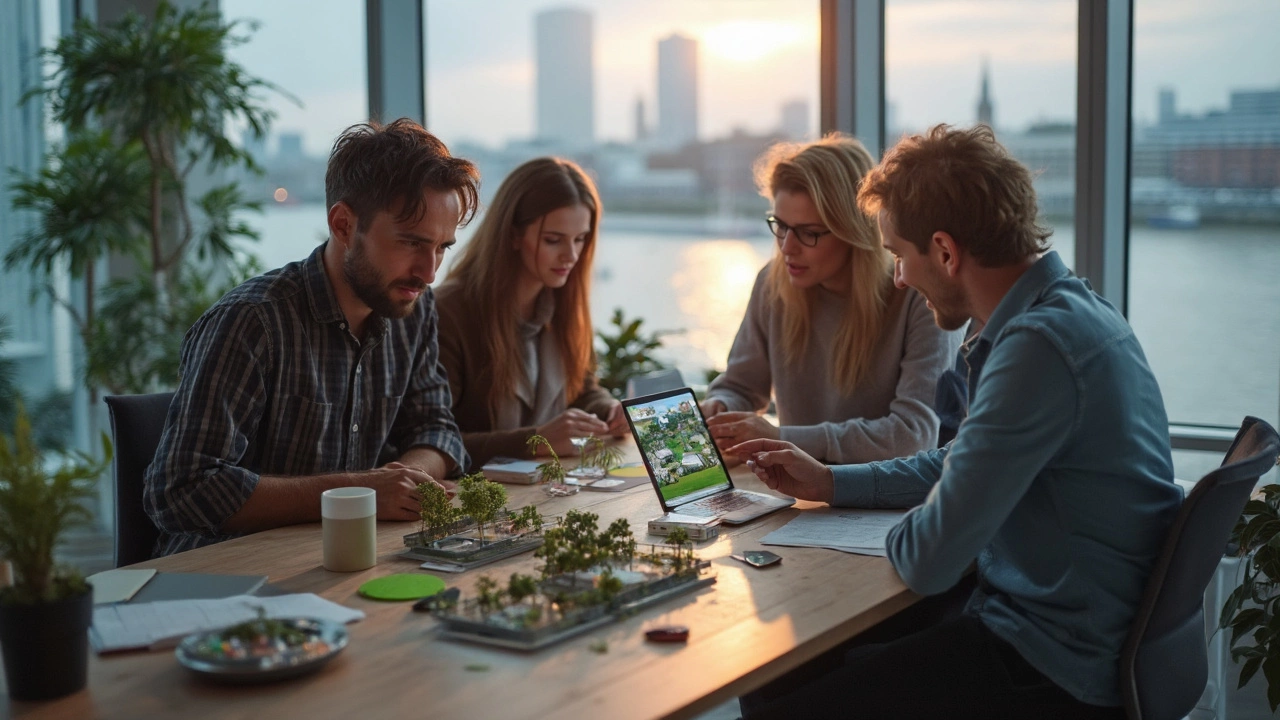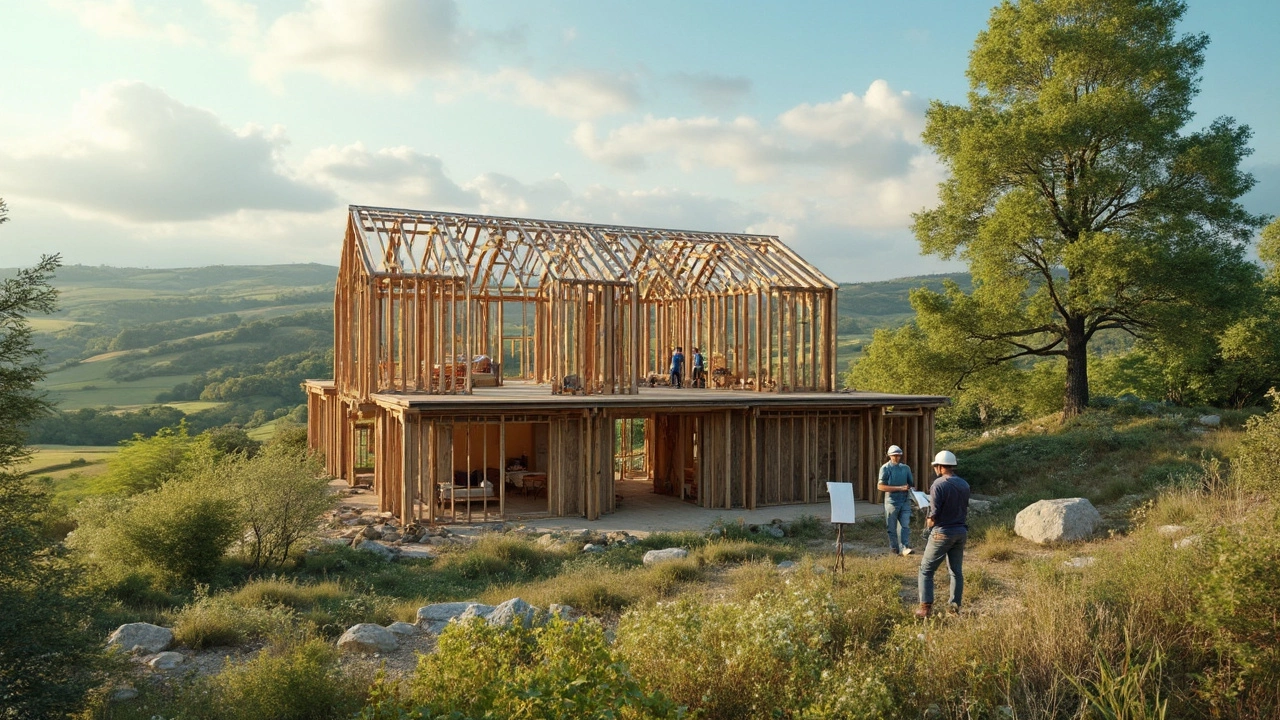So, you're thinking about building an eco-friendly home? That's fantastic! But before you get carried away with dreams of solar panels and rainwater harvesting systems, it's worth considering some of the speed bumps you might hit. First on the list is finding the right materials. Not all green materials are easy to get your hands on, and sometimes, you might need to source from far-off suppliers, adding to the carbon footprint you're trying to cut down.
And let's not even get started on the cost. Going green can mean shelling out more moolah upfront, whether for high-quality recycled materials or the latest in energy-efficient appliances. Sure, the savings on energy bills down the road can even things out a bit, but you need to be prepared for the initial sticker shock.
- Sourcing Sustainable Materials
- The Cost Factor
- Finding Skilled Professionals
- Navigating Regulations and Codes
- Keeping Up with Technology
- Balancing Aesthetics with Functionality
Sourcing Sustainable Materials
Going green sounds all nice and cozy until you actually start hunting down those sustainable materials for your dream eco-friendly home. It’s not just about grabbing any recycled or eco-certified material you find; it’s about finding the right stuff that suits your specific needs and design.
One of the biggest challenges is availability. Certain sustainable materials aren't exactly lining the aisles of your local home improvement store. For instance, materials like bamboo flooring or cork insulation might sound perfect, but they often need to be imported, and that comes with its own set of environmental cons.
Not only are you looking for stuff that does less harm to the planet, but you also want quality. Low-quality materials might be cheap, but they could need replacing sooner, which adds to both cost and waste. A report by Green Building Supply emphasized,
"Investing in high-quality, sustainable materials can significantly reduce the carbon footprint and extend the longevity of your home."
Another thing to chew over is the certification. Look out for labels like FSC (Forest Stewardship Council) or products with Cradle to Cradle Certification. They’re a quick way to know you’re buying something made with the earth in mind.
Let's make it practical:
- Research local suppliers: It's worth checking out what’s available near you. Local businesses might have sustainable materials that save on transportation emissions.
- Check stock regularly: Sustainable materials can run out quickly. Stay in the loop with your supplier about what’s in stock to avoid delays.
- Plan for extras: Order a little more than you need to account for mistakes or miscalculations. It’s way better than having to reorder and wait.
Sourcing these materials can sometimes feel like a treasure hunt, but getting it right means your home is one step closer to being the true green castle you envisioned.
The Cost Factor
Alright, let's talk money because honestly, building an eco-friendly home isn't cheap. The initial cost is usually the biggest hurdle for most folks. You're looking at spending more on everything from construction materials to labor compared to a standard build. But why is that, you ask?
First off, the price of sustainable materials like bamboo flooring, triple-pane windows, or high-efficiency insulation can be significantly higher. These goodies promise to be kinder to the environment but come with a heftier price tag. No skimping here if you really want a sustainable house.
Green building certifications are another expense. Many eco-construction projects aim for certifications like LEED, which can add costs not just for the certification itself, but also for meeting its strict requirements. If you're gunning for one of these, plan to set a bit more aside.
But here’s a cool thing: those upfront costs can pay off in the long run. Energy bills are often lower in these homes because of energy-saving tech like solar panels and efficient HVAC systems. Plus, homes with eco-friendly certifications often enjoy higher resale values.
Legal stuff might not be the most thrilling part of sustainable construction, but it's essential. Certain areas have incentives for green building, like tax breaks or reduced permit fees. However, they vary widely depending on where you're building. Do your research here; it could save you some serious cash.
Here's a quick look at how some costs compare:
| Feature | Traditional Cost ($) | Eco-Friendly Cost ($) |
|---|---|---|
| Insulation | 1,000 | 1,500 |
| Bamboo Flooring | 3,000 | 5,000 |
| Solar Panels | – | 10,000+ |
So, while the initial costs might make you pause, think of it as an investment in the future—not just for your wallet but for the planet. Isn’t it worth considering?
Finding Skilled Professionals
Wanna build a super cool eco-friendly home? You’re gonna need the right people on board. That’s one place where things can get a little tricky.
Let’s face it, not every contractor out there is a green building guru. It can be a challenge finding contractors and architects who not only share your vision for an environmentally friendly space but also have the chops to pull it off. Skilled professionals in sustainable construction aren't hanging out on every corner. But don’t worry, they’re out there if you dig a little.
First up, get cozy with online resources and communities. Websites like the Green Building Council or forums focused on green building challenges can be great places to start. These platforms often have directories or lists of verified professionals who specialize in eco-friendly projects.
Networking is also key. If you know anyone who's built a sustainable home, hit them up for recommendations. Sometimes a personal recommendation is gold, leading you straight to the right person.
Also, when you’re interviewing candidates, throw some testing questions their way. Ask them about their past eco-friendly projects or how they’d handle specific green building challenges. This will quickly show you who's really got the goods.
And here's a stat that might surprise you—according to the US Green Building Council, only about 11% of building industry professionals are currently certified in green building techniques. So, patience is the name of the game, but it's doable.
Remember, the right crew can make or break your dream project. Take your time finding folks who get your vision for a greener planet and have the know-how to turn that vision into reality.

Navigating Regulations and Codes
Building a eco-friendly home isn’t just about picking out sustainable materials and hoping for the best. You’ve got to deal with a maze of building regulations and codes. Local building codes can vary widely, so it’s essential to know what's expected in your area. These regulations ensure structures are safe, but they can seem like a mountain of paperwork. Talk about a headache, right?
First off, many regions have specific requirements for energy efficiency that your new home needs to meet. This means you'll need to work closely with knowledgeable folks who have experience in sustainable construction. Think architects and builders who get the eco-friendly thing. Pro tip: Check if your area offers incentives or rebates for building green. It can save you some bucks.
Don’t forget about zoning laws either. These dictate what you can build where. Want to install a wind turbine? Better make sure it's allowed in your neighborhood. Otherwise, you might have neighbors on your doorstep with pitchforks. Not literally, but you get the point.
Let's look at standards like LEED (Leadership in Energy and Environmental Design). It's a globally recognized symbol of sustainability achievement. While aiming for LEED certification is a fantastic goal, it requires strict adherence to guidelines, which can influence design decisions significantly.
In some areas, water usage laws might affect your plans. Installing a rainwater harvesting system or opting for low-flow fixtures could be mandatory. It's small details like these that can catch you off guard.
On top of this, with rules changing as fast as a cat on a hot tin roof, staying current is crucial. Reach out to local experts who can guide you through the ever-changing regulatory landscape. Keeping up with these regulations is not just smart but necessary to get your dream green building off the ground without any legal hiccups.
Keeping Up with Technology
Building an eco-friendly home today isn’t just about using natural materials or having a garden on the roof. It's also about integrating tech that keeps your home energy-efficient and sustainable. But with technology moving at lightning speed, it's a job in itself just to stay updated!
First off, there's home automation. With smart thermostats like the Nest or Ecobee, you can manage your home's temperature from your phone, ensuring no energy is wasted. These gadgets learn your routine and adjust accordingly, keeping your home comfy while cutting energy use.
Solar technology is another biggie. Jumping on the solar bandwagon might sound straightforward, but with panels getting more efficient and cheaper rapidly, choosing the right setup can be daunting. You don’t want to invest heavily in a setup that’s old news in a couple of years.
Then there's the whole realm of energy storage. Batteries like the Tesla Powerwall can store energy from your solar panels, allowing you to use solar energy even when the sun isn't shining. But, the tech is evolving, and you'll need to ensure your setup doesn’t become obsolete too quickly.
Keeping your home’s entire energy system up-to-date might seem like an uphill battle, but it's crucial for maintaining efficiency and savings. To give you a clearer picture:
| Technology | Current Advantage | Future Consideration |
|---|---|---|
| Smart Thermostats | Learn and optimize energy use | Integration with broader smart home systems |
| Solar Panels | Reduce electricity bills and carbon footprint | Improved efficiency and energy output |
| Energy Storage | Store solar energy for later use | Greater storage capacity and durability |
So, if you're building an eco-friendly home, keep your eyes peeled for the next big things in green tech. Staying informed might just save you a few headaches and some cash in the long run!
Balancing Aesthetics with Functionality
When it comes to building an eco-friendly home, making sure your space is both cool to look at and smart to live in is the ultimate dream. But let's face it, sometimes those green gadgets and lush materials don't come in the sleekest look. So how do you make sure your green haven doesn't end up looking like a science project? Simple—marry beauty with brains.
Start by choosing a design that naturally supports eco-friendliness. For instance, south-facing windows can harness more natural light, which means you're saving on electricity while bathing your home in a warm glow. If you're into wood, consider reclaimed varieties—they're not only a sustainable choice, but they also add a rustic charm.
Got your heart set on a metal roof for its durability? You can still make it part of your vision. These roofs can come in a variety of colors and finishes, so you're not stuck with just industrial gray. Plus, they reflect more sunlight, keeping your home cooler in hot months.
Then there's the question of technology. Integrating smart home features like automated lighting and temperature controls not only boosts energy efficiency but also adds a modern touch that can impress even the most tech-savvy guests. It's all about finding those little hacks to keep the place functional without sacrificing style.
Here's a quick tip: Sometimes less is more. Minimalist designs often need fewer materials and can make your home look modern and clutter-free. A good balance between open space and functional living can give you that airy feel while conserving resources.

